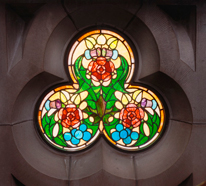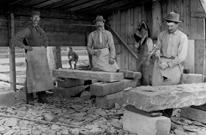© National Archives of Canada; Martin Lipman © Canadian Museum of Nature
Close.History and Buildings
Martin Lipman © Canadian Museum of Nature
Carved sandstone surrounds the 21 trefoil windows of the mezzanine. The identical windows depict stylized roses, thistles, grapes and leaves. Each rose seems to have more than five petals, which makes them all double roses, and therefore, not native to Canada. The stone is from Wallace, Nova Scotia.
The official name of our museum building is the Victoria Memorial Museum Building. Most of our exhibitions and programmes are offered there.
Our museum is proud to reside in the first building in Canada created to house a national museum. It's a national historic site and the birthplace of Canada's national museums. Historical timeline.
The site of our research, collections and administrative operations is the Natural Heritage Campus in Gatineau, Quebec.
© Library and Archives Canada
Scottish stonemasons at work on the Victoria Memorial Museum.
Architectural Style of the Museum
The Victoria Memorial Museum Building's chief architect and designer, David Ewart, created a fanciful castle-like structure that has been described as Scottish Baronial in design. Ewart's structures reflect the Romanesque and medieval styles of Europe, with a combination of Tudor and Gothic features.
The massing and interior articulation of the building are influenced by the Beaux-Arts style, which stressed symmetrical, axial plans.
The architecture was intended to mirror the Centre Block of Canada's original Parliament Buildings, one mile due north of the museum's site.
Martin Lipman © Canadian Museum of Nature
A stylized fox head, oak leaves and acorns adorn the newel of the main staircase. It is carved from Missisquoi grey-green marble. The cap and base are carved in Missisquoi bolder grey marble.
Despite the influence of European styles, the building designed by Ewart is firmly rooted in Canadian reality. The museum is one of the first public buildings to incorporate into its design animals and plants that are found in Canada. These are found in windows, exterior walls and interior embellishments, in addition to the two carved moose heads that guard the main entrance.
Exterior Stone
Rough Stone
- Most of the façade
- Nepean sandstone from Campbell Quarry, Nepean (now Ottawa), Ontario
- About 5% of the stone was replaced in 1995 to 1997 with stone from Les Carrières Ducharme, Havelock, Quebec.
Smooth Stone
- Decorative elements
- Wallace sandstone from Wallace Quarry, Wallace, Nova Scotia.
Steps and Landings
- Stanstead granite from Stanstead, Quebec.
© Canadian Museum of Nature
The front façade of the building is adorned with many similar sandstone carvings of animals and plants.








